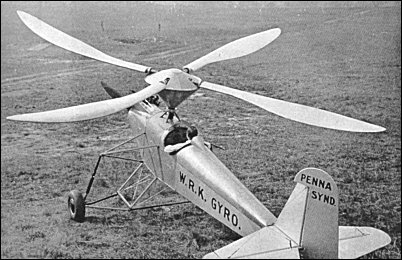|
A single-seat open-cockpit autogiro (X794W) made by E. Burke Wilford in Pennsylvania. First flew on August 5, 1931 piloted by Frank P. Brown. Wings were later removed and the ship made hundreds of successful flights before its crash in 1935, killing pilot Joseph McCormick. Model designation from initials of Wilford and German aero engineers Walter Reiseler and Walter Kreiser, upon whose patented 1927 designs the ship was based. A second version in 1934, for USN and NACA tests, was built up from a Fleet N2Y-1 fuselage and tail group as Pennsylvania XOZ-1 (8602). D.Francis "The Story of the Helicopter", 1946
Wilford's first aircraft, built in conjunction with Vincent Burnelli and entered for the Guggenheim Safe Airplane Contest in 1927, was especially designed for low-speed landing.
In 1928 Wilford visited Europe, and while there acquired the patent rights for the United States of a rotary wing aircraft conceived by a German named Rieseler. In 1929 Wilford began building his own gyroplanes.
The idea behind this American/German partnership was a scheme for feathering the pitch of the blades rotating round the hub instead of the blade flapping system which La Cierva employed in his autogyros.
Wind-tunnel tests proved the effectiveness of the idea, and the first Wilford gyroplane made successful flights in 1931.
Constant improvements in the rotor enabled the aircraft's original fixed wings gradually to be dispensed with.
In 1937 Wilford built a gyroplane for the United States Navy. It proved very successful, especially when tested by the National Advisory Committee for Aeronautics, but nothing tangible ever materialized. Gyroplane, 1931
This was the aircraft built for Wilford which applied the ideas of two Germans, Rieseler and Kreiser, and embodied a system for feathering the rotor blades in flight. The feathering control, operated through a system of cams, affected only the lateral parts of the circle described by the rotor.
The original model had an engine of only 85hp, but it nevertheless flew with some success when tested at Paoli, Pennsylvania, by F.P.Brown in August 1931.
As a result of these tests, various improvements were later made, such as a much more powerful engine, increase in the size of the rotor, and extension of pitch control to the four quadrants of the circle described by it. P.Lambermont "Helicopters and Autogyros of the World", 1958
| Technical data for WRK Gyroplane
Number of seats: 1,
engine: 1 x ACE Mark III rated 85hp, repowered with 165hp Jacobs,
wingspan: 7.01m,
rotor diameter: 9.14m,
height: 3.05m,
weight fully loaded: 816kg,
max. speed: 190km/h,
min. speed: 50km/h
|
Warning: mysqli_connect(): php_network_getaddresses: getaddrinfo for mysql5.zone.ee failed: Name or service not known in /data03/virt15346/domeenid/www.aviastar.org/htdocs/helicopters_eng/wilford.php on line 103
Fatal error: Uncaught mysqli_sql_exception: php_network_getaddresses: getaddrinfo for mysql5.zone.ee failed: Name or service not known in /data03/virt15346/domeenid/www.aviastar.org/htdocs/helicopters_eng/wilford.php:103
Stack trace:
#0 /data03/virt15346/domeenid/www.aviastar.org/htdocs/helicopters_eng/wilford.php(103): mysqli_connect('mysql5.zone.ee', 'd14657sa18989', Object(SensitiveParameterValue))
#1 {main}
thrown in /data03/virt15346/domeenid/www.aviastar.org/htdocs/helicopters_eng/wilford.php on line 103
| 




